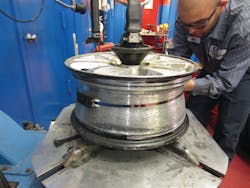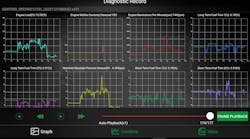Q: What do I need to be getting into the business of low-profile tires?
A: Generally, you will need a right hand assist arm (which is on the left hand side of the machine, depending on where you are standing, of course). Ultimately, it depends on the configuration of your machine. Your tire machine company might make add-ons for your machine that will enable you do this. If you have an old school machine there are ways around it, such as using a second guy or using certain tools like a bead depressor tool. It might be necessary to update equipment. To do tires quickly and prevent the rim being scratched, you might want to consider a "touchless" machine that removes the tire from the rim without the use of a tire iron.
Q: Why does my balancer zero out, but the tires come back with shaking complaints?
A: Rims are getting bigger these days and the older and less advanced equipment will balance out, but shake at higher speeds. Generally, such equipment calls for more weight and just does not cut it in the "accuracy department."
What can you do about it? You can make sure there is no dirt under your machine and that it is tightly bolted to the shop floor. Lastly, the cheaper and older machines might need to be calibrated frequently in order to get their maximum accuracy. If you are still having comebacks, it is time to assess whether it is worth upgrading your machine.
Q: Do the more advanced tire changers need training to use?
A: Yes. The simple ones have been known to crush fingers and break arms. Now, the really advanced machines come with video cameras and several assist arms that are controlled with joysticks. Pete Liebetru of Hunter observed that the cheapest machines required the least training, the middle machines the most, and then the most expensive are so automated the need for training begins to drop off. Of particular importance is the fact that "much of the training is really more related to the tire being serviced than the tire changer. In other words, run-flats need more training than a standard tire no matter what equipment you use," according to Liebetru.
Q: What's the benefit of premier tire equipment over economy equipment?
A: This would depend upon the volume you do in your shop. Economy equipment might be sufficient if you do a low volume of tires, but even under light use they can have problems in as few as a couple of years.
Also, no matter how good and accommodating the tech support is for some of this equipment such as that of the higher-end imported tool distributors, because the machines are cheap there are not a lot of repairmen out there that work on them. This can mean long wait times for repairs for your tire equipment.
Basic equipment aside, rims on normal vehicles are all becoming low profile and some quite big. Oftentimes, they won't balance right (or comeback with a shaking issue) unless they are done on a high-end balancer. If your balancer calls for a lot of weight and the wheel shows no obvious defects, your machine likely has issues balancing that rim.
There are many amenities that a top-of-the-line balancer offers. Advanced wheel balancers have a laser sight, so you don't have to bend over and "guesstimate" where to put the weights. Many will automatically measure all of the elements of tire size in one automatic movement and on a digital screen walk you through the balance. Some machines even spin the tire into position to put the weight. Others apply load to the tire to simulate real-world driving conditions and check to see if the tire itself was mounted in the best possible position to prevent balancing issues. Unlike in the past, the newest "diagnostic balancers" can be operated as quickly as standard balancers, with literally a second or two difference at most.
Q: Should I plug or patch tires?
A: Always do what is best for you and your customer.
If your clientele does not want to pay too much for a tire repair, plugging is technically a viable option for fixing a tire. However, major industry associations such as the Rubber Manufacturers Association and Tire Industry Association as well as tire companies do not recommend it. In the state of New York, the practice was illegalized as recently as June.
The truth is that plugs do work on the majority of tire leaks and they tend to last until the point the tread wears too low. However, a plug is only a "quick fix," and is not the highest quality of repairs.
To properly plug a tire, the mechanic should remember a few things. One would be to never use more than one plug. Another is to remember to use rubber cement to lubricate the plug and help seal the plug on the inside. A rumor has sprung up that the rubber cement is counterproductive. In reality, rubber cement solidifies into a rubber, and it helps fill in gaps in the plug. So, do not skimp on the rubber cement.
Now, the benefit of patching is that it is a more comprehensive repair. A tire with a nail/screw in it cannot be plugged if the puncture exists at more than a 25-degree angle. Oftentimes, a plug at a high angle will just expand the puncture and so it cannot be sealed. Furthermore, no tire company actually recommends the plug for liability reasons. In fact, companies that sell the plugs will not go on the record to recommend a plug over a patch. The accepted best industry practice is to plug and patch a tire.
So, no one questions whether a plug works. In general, it does. The patch is just better for liability reasons and it is technically a better repair.


